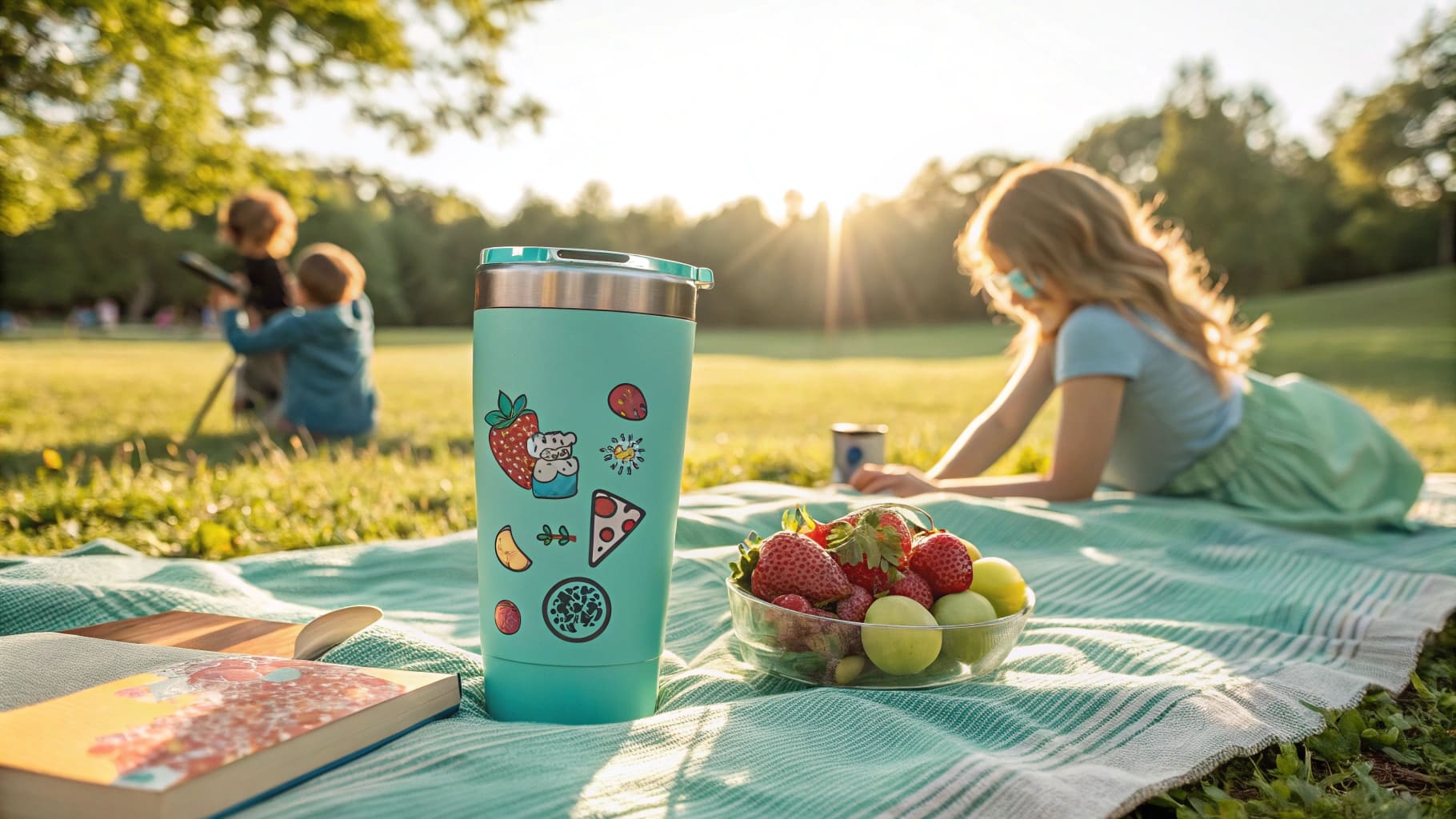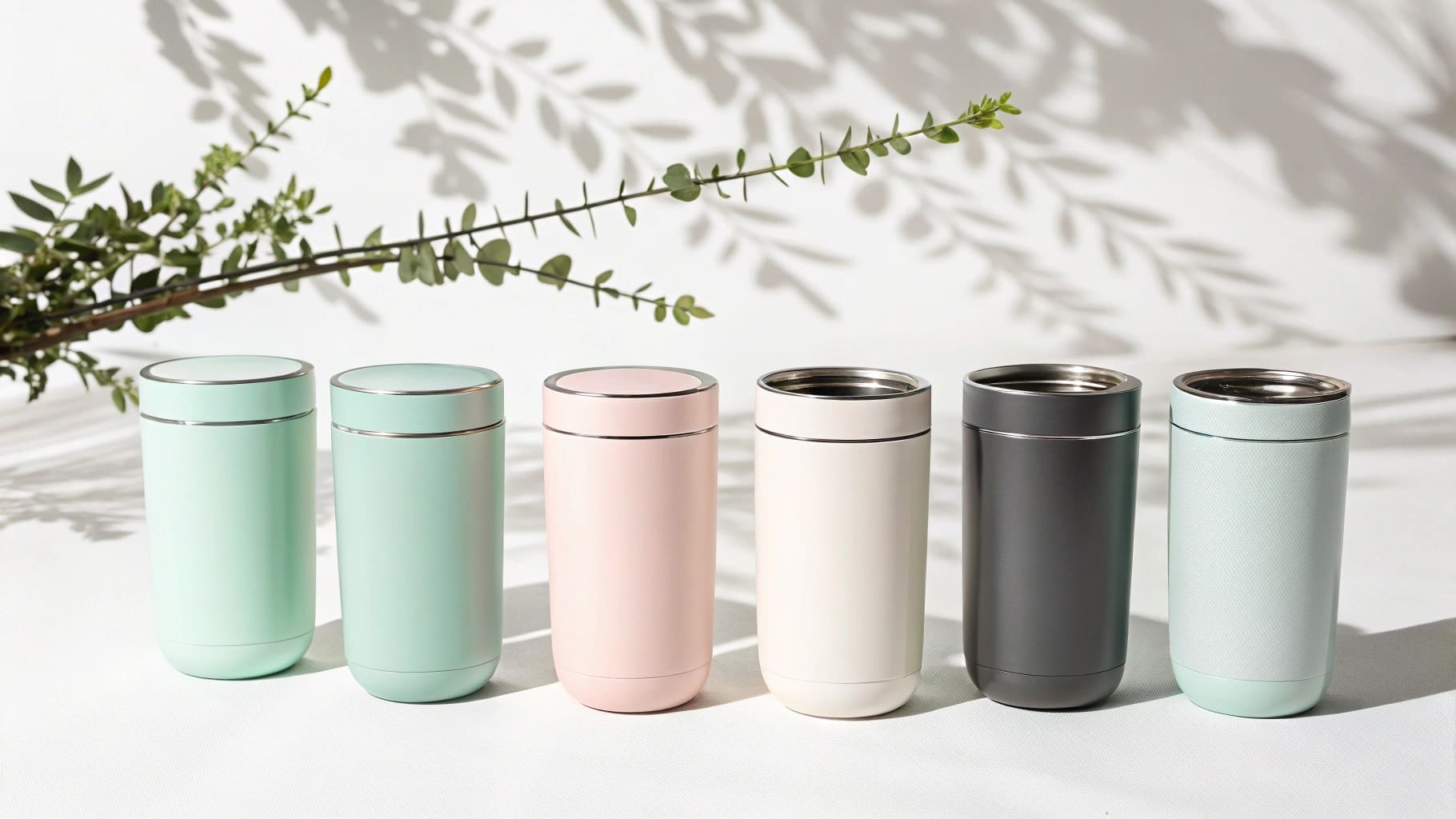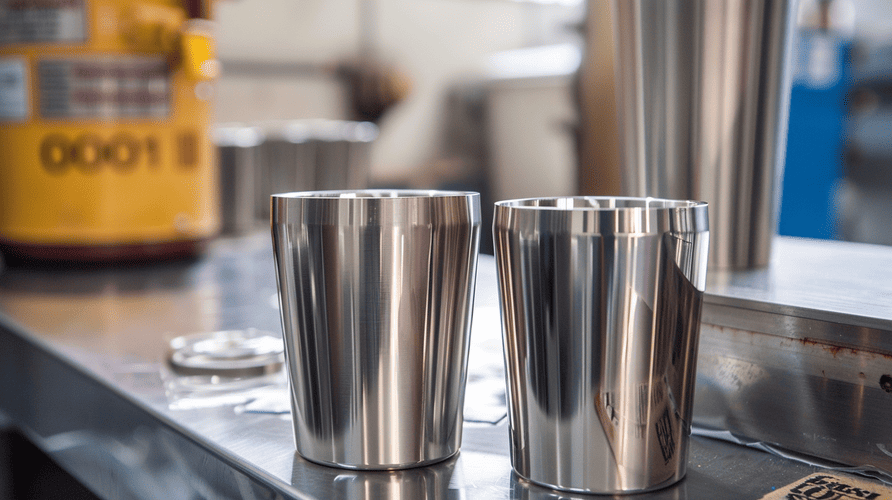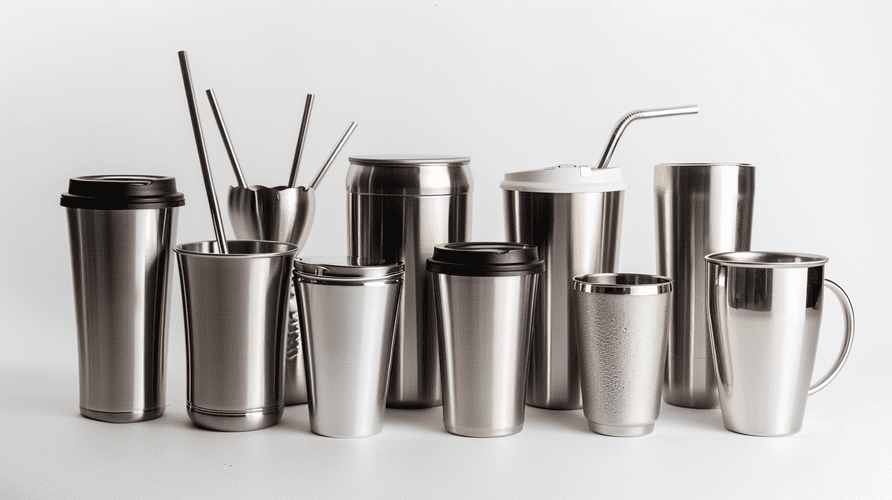Tired of boring, disposable cups? You see stylish steel cups everywhere and wonder if they're just a trend. Discover how they perfectly blend health, style, and everyday practicality.
Stainless steel cups have become a fashion statement because they combine modern aesthetics with core user values. Consumers choose them for their health benefits (BPA-free), eco-friendliness (reusable), and customizable style, making them a personal accessory, not just a cup.

This shift from a purely functional item to a fashion accessory is fascinating. As a manufacturer at Icobottle, I get a lot of questions about this from B2B buyers, like my Canadian client, Mark. They see the trend, but they need to understand the practical details that drive it. They want to be sure the product they sell is as good as it looks. Let's break down the common questions I hear all the time.
Are Stainless Steel Cups Good to Drink Out Of?
Worried about a metallic taste or the safety of your drink? You hear conflicting information about drinking from metal containers. Let me explain why high-quality stainless steel is an excellent choice.
Yes, high-quality stainless steel cups are excellent to drink from. Food-grade 304 (18/8) stainless steel is specifically designed to be non-reactive. This means it won't leach chemicals or alter the taste of your beverage, ensuring a pure and safe drinking experience every time.

When clients like Mark ask about safety, my answer always starts with the material. Not all steel is the same. The key is "food-grade." We use 304 stainless steel, which is also known as 18/8 stainless steel because it's made of 18% chromium and 8% nickel. This specific composition is what makes it a champion for drinkware.
What Makes 304 Stainless Steel Safe?
The chromium in the steel is the real hero here. It reacts with oxygen in the air to form a thin, invisible, and very stable layer on the surface. This is called a "passive layer." It acts as a barrier that prevents the iron in the steel from rusting and stops any metal from getting into your drink. This is why you don't get that metallic taste you might associate with cheaper metal cups. It’s also incredibly durable, resisting scratches and dents where bacteria could otherwise hide.
Material Comparison for Drinkware
To put it in perspective, let's see how it stacks up against other common materials.
| Feature | Stainless Steel (304) | Plastic | Glass |
|---|---|---|---|
| Health Safety | Excellent, no leaching | Can leach chemicals (e.g., BPA) | Excellent, completely inert |
| Taste Purity | Excellent, no flavor transfer | Can retain old flavors/odors | Excellent, no flavor transfer |
| Durability | Very high, shatterproof | Varies, can crack or warp | Low, easily shatters |
| Practicality | Great for hot & cold, portable | Lightweight, but less durable | Not ideal for travel or kids |
For a business, this means you're offering a product that delivers on its promises of safety and quality, building trust with the end consumer.
What Can You Put in a Stainless Steel Cup?
Unsure if your favorite morning coffee or afternoon smoothie is safe in a steel cup? You don't want to risk ruining your cup or your drink. Here’s a simple guide to what's compatible.
You can put almost any beverage in a high-quality stainless steel cup. This includes hot drinks like coffee and tea, cold drinks like water and juice, and even dairy like milk or smoothies. Its non-reactive surface handles various temperatures and contents safely.

One of the best features of 304 stainless steel is its versatility. This is a huge selling point for my B2B clients because it means the final product appeals to the widest possible audience. A person can use the same cup for their morning coffee, their water at the gym, and a cold juice in the afternoon.
Hot, Cold, and Everything In Between
Stainless steel is a fantastic insulator, especially in double-walled vacuum designs1. This means it can keep hot drinks hot for hours and cold drinks cold for even longer. Unlike some plastics, it won't warp or release chemicals when filled with a hot liquid like boiling water for tea. And unlike glass, you don't have to worry about it cracking from a sudden temperature change.
Common Beverages and Stainless Steel
Here’s a quick look at how stainless steel handles different types of drinks.
| Beverage Type | Compatibility with 304 Steel | Notes |
|---|---|---|
| Water | Excellent | The purest way to stay hydrated. |
| Coffee & Tea | Excellent | Holds temperature well; won't stain or hold flavors. |
| Juice & Soda | Excellent | Safe even with acidic or carbonated drinks. |
| Milk & Smoothies | Good | Perfectly safe, but clean promptly to prevent bacteria. |
| Alcohol | Good | Fine for cocktails, wine, beer. Don't store hard liquor long-term. |
This versatility makes it a simple choice for consumers and a reliable product for distributors. You can confidently market it as the one cup for everything.
Can You Put Lemon Water in a Stainless Steel Cup?
Heard that acidic drinks can damage metal? You love your daily lemon water but worry it will corrode a stainless steel cup and ruin the taste. Let's clear up this common and important question.
Yes, you can safely put lemon water in a high-quality stainless steel cup. Food-grade 304 stainless steel contains chromium, which creates a passive, corrosion-resistant layer2. This shield protects the metal from the mild acid in lemon juice, preserving both the cup and your drink.

This is a technical question I get from detail-oriented buyers. They are right to be cautious, as some metals do react poorly with acid. For example, you should never put acidic drinks in an aluminum container, as it can cause the metal to leach into your drink. But high-quality stainless steel is a different story.
The Science of Corrosion Resistance
As I mentioned before, the chromium in 18/8 stainless steel creates a protective layer. Citric acid from a lemon is a weak acid. It is not strong enough to break down this stable, passive layer. Because of this, the steel doesn't rust or corrode, and your water doesn't get a metallic taste. You can enjoy your lemon water without any worries. This is a key part of what makes it "food-grade."
Why Quality Matters for Acidic Drinks
The key phrase here is "high-quality." If you buy a very cheap, unbranded metal cup, you can't be sure what it's made of. It might be a lower grade of steel or another metal altogether. That is where you risk corrosion and off-tastes. When I work with clients, I provide material certifications to prove our products are made from genuine 304 stainless steel. This assurance is critical for anyone selling drinkware, as it guarantees the product is safe for all common beverages, including acidic ones.
Why Do People Use Stainless Steel Cups?
You might still see cheap plastic cups everywhere. So you wonder what's really driving the massive shift towards stainless steel drinkware. The answer is a powerful combination of three modern consumer trends.
People use stainless steel cups for three main reasons: health, sustainability, and style. They want to avoid the potential chemicals in plastic (like BPA), reduce single-use waste, and enjoy a durable, modern product that can be personalized to reflect their identity.

Understanding these drivers is key for any brand in this market. The stainless steel cup isn't just a product; it's a reflection of the consumer's values. I've seen this evolution firsthand. It’s no longer just about function.
The Health-Conscious Consumer
First, people are more aware of what they put in their bodies. News about chemicals like BPA (Bisphenol A) in plastics has made many people search for safer alternatives. Stainless steel provides peace of mind. It’s a stable, inert material that doesn't need chemical liners. For parents buying water bottles for their kids or fitness enthusiasts hydrating at the gym, "BPA-free" is a powerful reason to choose steel.
The Eco-Friendly Movement
Second, there is a global movement to reduce waste. Every day, people see images of plastic bottles polluting the oceans. A reusable stainless steel cup is a simple, effective way for an individual to fight this problem. They are incredibly durable and can last for years, replacing thousands of single-use plastic cups and bottles. This makes it an easy choice for the environmentally conscious shopper.
The Style Statement
Finally, these cups have become a fashion accessory. With a huge range of colors, finishes, and the ability to add custom logos or designs, a cup is now a way to express personal style. People carry them everywhere, from the office to the hiking trail. It says something about who they are: healthy, eco-aware, and modern. This is where my business thrives, by helping brands create cups that perfectly match their own image.
What is the Healthiest Cup to Drink From?
Overwhelmed by all the choices for drinkware? You just want to know which material is genuinely the safest and healthiest for you and your family. Let's compare the top contenders simply.
While glass is inert and very safe, high-quality 304 stainless steel is often considered the healthiest practical option. It’s non-leaching, durable, and shatterproof. This combines the chemical safety3 of glass with the resilience needed for an active, everyday life.

When we talk about the "healthiest" option, we have to consider both chemical safety and practical, real-world use. My clients need to sell a product that is not just safe but also convenient for their customers.
Glass: The Pure but Fragile Choice
Glass is fantastic from a purity standpoint. It's completely inert, meaning it will never leach anything into your drink or hold onto old flavors. If you only ever drank at your desk or kitchen table, glass would be a perfect choice. However, its big weakness is that it's heavy and breaks easily. This makes it impractical and often unsafe for travel, sports, or for children to use.
Plastic: The Convenience with a Catch
Plastic is lightweight and cheap, but its health profile is questionable. Even "BPA-free" plastics can contain other chemical compounds that people are wary of. Plus, plastic can absorb flavors and odors over time, and it scratches easily, creating places for bacteria to grow. Many people are choosing to move away from plastic for daily use.
Stainless Steel: The Balanced Champion
This is where stainless steel shines. It offers the same inert, non-leaching4 safety as glass but in a package that's virtually indestructible. It doesn't break, it's relatively lightweight, and it keeps drinks at the right temperature.
| Material | Health Safety | Durability | Practicality for Daily Use |
|---|---|---|---|
| Glass | Excellent | Poor | Poor |
| Plastic | Fair | Fair | Good |
| Stainless Steel | Excellent | Excellent | Excellent |
For a combination of pure health safety and the durability needed for a modern, active lifestyle, stainless steel is the clear winner. It's the healthiest choice that you can actually use everywhere, every day.
Conclusion
In summary, stainless steel cups offer the perfect mix of safety, style, and sustainability. They are a reliable and fashionable choice for modern consumers and a smart investment for brands.
-
Learn about double-walled vacuum designs and how they enhance insulation for hot and cold beverages, ensuring optimal temperature retention. ↩
-
Discover how corrosion-resistant layers work to protect metals, ensuring your drinkware remains safe and effective for acidic drinks. ↩
-
Understanding chemical safety in drinkware materials is crucial for making informed choices about what you drink from. ↩
-
Learn about non-leaching materials and why they are essential for ensuring the safety of your beverages. ↩

